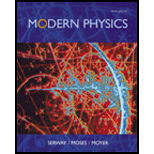
(a)
The number of modes with wavelength between
(a)
Answer to Problem 7P
The number of modes with wavelength between
Explanation of Solution
Write the expression for the number of modes of vibration of waves which is confined by a cavity that is related to wavelength and length of the string is,
Here,
Re-write the expression (I),
Write the number of modes with wavelength between
Here,
Conclusion:
Substitute
Thus the number of modes with wavelength between
(b)
The number of modes per unit wavelength per unit length.
(b)
Answer to Problem 7P
The number of modes per unit wavelength per unit length is
Explanation of Solution
Write the expression the number of modes per unit wavelength per unit length,
Here,
Conclusion:
Substitute
The number of modes per unit wavelength per unit length is
(c)
The expression obtained the same value as found in sub part (a).
(c)
Answer to Problem 7P
The expression obtained the same value as found in sub part (a) that is the number of modes with wavelength between
Explanation of Solution
Write the expression the number of modes is,
Here,
Re-write the expression (I) by differentiating the term, for the number of modes per unit wavelength per unit length of the string,
Re-write the expression (II) for number of modes,
Conclusion:
Substitute
The expression obtained the same value as found in sub part (a) that is the number of modes with wavelength between
(d)
The reason to justify replacing
(d)
Answer to Problem 7P
For the shorter wavelengths
Explanation of Solution
Write the expression the number of modes per unit wavelength per unit length,
Here,
Considering
Conclusion:
For the shorter wavelengths
And also for the shorter wavelengths
Want to see more full solutions like this?
Chapter 3 Solutions
Modern Physics
- If STM is to detect surface features with local heights of about 0.0200 nm, what percent change in tunneling-electron current must the STM electronics be able to detect? Assume that the tunneling-electron current has characteristics given in the preceding problem.arrow_forwardIn STM, an elevation of the tip above the surface being scanned can be determined with a great precision, because the tunneling-electron current between surface atoms and the atoms of the tip is extremely sensitive to the variation of the separation gap between them from point to point along the surface. Assuming that the tunneling-electron current is in direct proportion to the tunneling probability and that the tunneling probability is to a gotxi approximation expressed by the exponential function e2L with =10.0/nm , determine the ratio of the tunneling current when the tip is 0.500 nm above the surface to the current when the tip is 0.515 nm above the surface.arrow_forwardConsider scattering with electrons of 54 eV on a crystal with planes separated by 0.22 nm. How many diffraction peaks should be expected? Justify your answerarrow_forward
- Could someone explain to me in detail why bringing a crystal substance to absolute zero isn't possible? I know it's not because of quantum mechanics and uncertainty like some people say, because particals at their lowest zero-point will have a temperature of exactly 0 K, even though they're still experiencing motion. From what I've gathered, the energy or time required to pull it off is infinite, but I can't find any equations or clear explanations as to why or how that is. And I also don't know if there's any other reasons beyond that. If you could give me a thourough a breakdown for how absolute zero is impossible as you possibly could, I'd greatly appreciate it. Take as much extra time as you need. As long as it's detailed and correct I'm happy. Though ideally I would before it come in before the end of the day.arrow_forwardThe potential wave analysis of scattering one has to consider waves with L=0,1,2,3 for a given energy for spherically symmetric potentials having range ro,up to what value of L should one considerarrow_forwardShow that the uncertainty in the momentum of a ground-state harmonic oscillator is (where h is h-bar, m is the mass, and k is the spring constant).arrow_forward
- Consider scattering with electrons of 50 eV on a crystal with planes separated by .3 nm. How many difraction peaks are expected? Needs Complete typed solution with complete explanation and 100 % accuracy.arrow_forwardA certain atom has a doubly degenerate ground level, a triple degenerate electronically excited level at 1250 cm-1, and a doubly degenerate level at 1300 cm-1. Calculate the partition function of these electronic states at 2000 K.arrow_forwardAt time t = 0 the wave function for a particle in a box is given by the function in the provided image, where ψ1(x) and ψ1(x) are the ground-state and first-excited-state wave functions with corresponding energies E1 and E2, respectively. What is ψ(x, t)? What is the probability that a measurement of the energy yields the value E1? What is <E>?arrow_forward
 Principles of Physics: A Calculus-Based TextPhysicsISBN:9781133104261Author:Raymond A. Serway, John W. JewettPublisher:Cengage Learning
Principles of Physics: A Calculus-Based TextPhysicsISBN:9781133104261Author:Raymond A. Serway, John W. JewettPublisher:Cengage Learning Modern PhysicsPhysicsISBN:9781111794378Author:Raymond A. Serway, Clement J. Moses, Curt A. MoyerPublisher:Cengage Learning
Modern PhysicsPhysicsISBN:9781111794378Author:Raymond A. Serway, Clement J. Moses, Curt A. MoyerPublisher:Cengage Learning University Physics Volume 3PhysicsISBN:9781938168185Author:William Moebs, Jeff SannyPublisher:OpenStax
University Physics Volume 3PhysicsISBN:9781938168185Author:William Moebs, Jeff SannyPublisher:OpenStax Classical Dynamics of Particles and SystemsPhysicsISBN:9780534408961Author:Stephen T. Thornton, Jerry B. MarionPublisher:Cengage Learning
Classical Dynamics of Particles and SystemsPhysicsISBN:9780534408961Author:Stephen T. Thornton, Jerry B. MarionPublisher:Cengage Learning Physics for Scientists and Engineers with Modern ...PhysicsISBN:9781337553292Author:Raymond A. Serway, John W. JewettPublisher:Cengage Learning
Physics for Scientists and Engineers with Modern ...PhysicsISBN:9781337553292Author:Raymond A. Serway, John W. JewettPublisher:Cengage Learning




